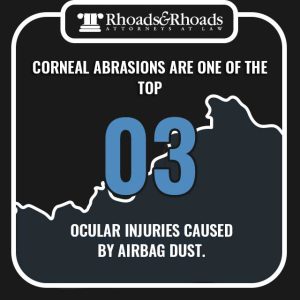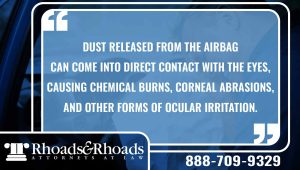
Airbags have been a revolutionary safety feature in motor vehicles, credited with saving countless lives in serious car accidents. However, while air bags are designed to protect occupants from severe trauma, their deployment can also lead to eye injury or injuries and severe ocular trauma. One often overlooked culprit is the airbag dust or powder released during automobile air bag activation, which can cause significant damage to the eyes if it comes into direct contact.
In this comprehensive blog post, we’ll explore the various types of eye injury that can result from airbag deployment, the potential risks associated with air bag dust when an airbag deploys, and what legal recourse may be available for those who have suffered an airbag-related ocular injury in a car crash.
Understanding Air Bag Deployment and Serious Eye Injuries
Air bags are designed to deploy and inflate rapidly during a collision, cushioning the occupant and preventing them from hitting the steering wheel, dashboard, or windshield. This rapid inflation of airbags is achieved through the use of an explosive charge that inflates airbags within milliseconds.
While this process is essential for effective occupant protection, it can also contribute to eye injury in several ways:
Blunt Trauma
 The force of the inflating airbags can cause blunt trauma to the eye, potentially leading to airbag injuries such as corneal abrasions, hyphemas (bleeding in the front of the eye), vitreous hemorrhages (bleeding in the back of the eye), and even retinal detachments.
The force of the inflating airbags can cause blunt trauma to the eye, potentially leading to airbag injuries such as corneal abrasions, hyphemas (bleeding in the front of the eye), vitreous hemorrhages (bleeding in the back of the eye), and even retinal detachments.
Air Bag Dust and Powder
As the airbag deploys, it releases a fine powder or dust composed of various chemicals, including sodium hydroxide, sodium azide, and talcum powder. This dust can come into direct contact with the eyes, causing chemical burns, corneal abrasions, and other forms of ocular irritation.
Projectile Debris
In some cases, particularly with defective or improperly designed air bags, small fragments or debris can be propelled into the occupant’s face and eyes when airbags deploy, leading to lacerations, foreign body injury or injuries, and other forms of ocular trauma in a car crash.
The severity of these airbag injuries can range from minor irritation to severe vision-threatening conditions, depending on the nature of the impact and the presence of any underlying eye conditions, eye injury, or risk factors.
Common Airbag-Related Eye Injuries
While airbag deployment can cause various types of eye injury, some of the most commonly reported conditions include:
Corneal Abrasion
This eye injury includes scratches or scrapes on the cornea, the clear front part of the eye. A corneal abrasion can be caused by airbag force, as well as by the airbag dust or debris. They can be incredibly painful and may lead to vision problems if left untreated.
Chemical Keratitis
 One of the most severe forms of ocular injury from airbag deployment is alkaline chemical keratitis. This condition occurs when the alkaline chemicals in the airbag dust, such as sodium hydroxide, come into direct contact with the eyes. The alkaline dust can cause significant alkali burns to the cornea and surrounding tissues. Alkaline chemical keratitis is excruciating, with the patient complaining of severe eye pain, redness, tearing, light sensitivity and light perception, and blurred or blurry vision. Prompt treatment in an emergency medicine setting is crucial, as these types of alkali burns from airbags are extremely hazardous and can rapidly lead to permanent vision loss if not addressed immediately.
One of the most severe forms of ocular injury from airbag deployment is alkaline chemical keratitis. This condition occurs when the alkaline chemicals in the airbag dust, such as sodium hydroxide, come into direct contact with the eyes. The alkaline dust can cause significant alkali burns to the cornea and surrounding tissues. Alkaline chemical keratitis is excruciating, with the patient complaining of severe eye pain, redness, tearing, light sensitivity and light perception, and blurred or blurry vision. Prompt treatment in an emergency medicine setting is crucial, as these types of alkali burns from airbags are extremely hazardous and can rapidly lead to permanent vision loss if not addressed immediately.
Air bag keratitis and other corneal abrasions from the fine particulate matter in the airbag dust are also common airbag-related eye injuries. Even minor abrasions can cause foreign body sensation, tearing, light sensitivity and light perception, and decreased visual acuity. In some cases, multiple small abrasions occur, further compounding the ocular discomfort and eye injury.
Hyphema
A hyphema eye injury is a collection of blood in the anterior chamber of the eye, between the cornea and iris. It can be caused by airbag blunt force trauma and may require immediate medical attention to prevent further complications. While blunt trauma from the deploying airbag is the leading cause of serious eye injuries like hyphema, vitreous hemorrhage, and retinal detachment, the dust itself can contribute to or exacerbate these conditions. The abrasive nature of the particulates can worsen any lacerations or ruptures in the delicate ocular tissues caused by the initial impact from the airbags.
Vitreous Hemorrhage
This serious injury is bleeding within the vitreous humor, the gel-like substance that fills the back portion of the eye. Vitreous hemorrhages can obscure vision and, in severe cases, the eye injury may lead to retinal detachment or other serious complications after an accident.
Retinal Detachment
The force of airbags can cause the retina (the light-sensitive layer at the back of the eye) to become detached from its underlying supportive tissues. Retinal detachment is a medical emergency that can lead to permanent vision loss if not treated promptly using emergency medicine.
Orbital Fractures
The impact of airbags can sometimes cause fractures in the bones surrounding the eye (the orbit), which can lead to double vision, eye muscle dysfunction, and other vision problems.
Eyelid Lacerations
The force of airbags or any debris released during deployment can cause cuts or lacerations to the eyelids, potentially leading to scarring or other complications.
One case report published in the J Emerg Med described a 43-year-old woman who was involved in a head-on collision. While she was wearing her seat belt, the driver’s side airbag deployed, and the patient complained of severe left eye pain, blurred vision, and vision loss. Upon examination at the ophthalmology service, she had a large corneal abrasion, hyphema, choroidal rupture, and her visual acuity in the left eye was reduced to only being able to count fingers. Her injuries were a direct consequence of exposure to the airbag dust and blunt trauma from the deploying airbag.
Wearing glasses at the time of the motor vehicle accident and airbag deployment has been identified as a factor for more severe ocular injuries, as the glasses can shatter or cause lacerations when the airbag makes forceful contact, leading to bilateral eye injury. Foreign bodies like shards of broken lenses from eyeglass wear can become embedded in the eye, necessitating surgical removal after an accident involving airbags.
While these injuries can occur during any airbag deployment, certain factors may increase the risk or severity of the ocular injury, such as:
- Pre-existing eye conditions or previous eye surgeries
- Sitting too close to the airbag deployment area
- Defective or improperly designed air bags
The Role of AirBag Dust in Ocular Injuries
One aspect of airbag deployment that is often overlooked is the release of a fine powder or dust during the inflation process. This dust is composed of various chemicals used to facilitate the rapid inflation of the air bag, including sodium azide and talcum powder.
While these chemicals are essential for the proper functioning of the air bag system, they can be incredibly harmful to the eyes if they come into direct contact.
Here’s how airbag dust can contribute to ocular injuries:
 Chemical Burns: Sodium hydroxide, commonly known as lye, is a highly alkaline substance that can cause severe chemical burns to the eyes. When air bag dust comes into contact with the eyes, it can lead to chemical keratitis, a condition characterized by intense pain, redness, tearing, and potential vision impairment.
Chemical Burns: Sodium hydroxide, commonly known as lye, is a highly alkaline substance that can cause severe chemical burns to the eyes. When air bag dust comes into contact with the eyes, it can lead to chemical keratitis, a condition characterized by intense pain, redness, tearing, and potential vision impairment.- Corneal Abrasions: The fine particles of talcum powder and other substances present in airbag dust can act as abrasive agents, causing scratches or abrasions on the cornea. Multiple abrasions can be extremely painful and may increase the chance of corneal scarring or other complications if left untreated.
- Ocular Irritation: Even in cases where the airbag dust does not cause chemical burns or abrasions, the presence of these foreign particles in the eyes can lead to significant irritation, redness, tearing, and discomfort.
It’s important to note that the risk of airbag dust-related eye injuries is not limited to the occupants of the vehicle. In some cases, bystanders or pedestrians in the vicinity of the accident may also be exposed to the dust released during airbag deployment, potentially leading to similar eye-related complications.
Legal Recourse for Airbag-Related Eye Injuries
While the precise incidence and public health impact of airbag dust-related eye injuries is not yet well-documented, case reports and studies in the ophthalmology literature including J Emerg Med suggest that they are an under appreciated problem that warrants further attention, especially given the widespread use of airbags and their proven ability to save lives in serious crashes.
From a product liability standpoint, safer airbag designs that minimize dust and particulate exposure could reduce the toxic potential and overall ocular morbidity associated with this life-saving technology. While airbags must inflate rapidly to be effective, the chemicals used as propellants and lubricants should be carefully evaluated to mitigate the risk of eye injury to vehicle occupants exposed during deployment.
If you or a loved one has suffered an ocular injury due to airbag deployment in motor vehicle crashes, it’s important to understand your legal rights and options for seeking compensation.
Depending on the circumstances of your case, you may be able to pursue a personal injury claim against the responsible parties for the airbags when injuries occur, including:
- Vehicle Manufacturer: If the airbag system was defective or improperly designed, leading to excessive force, debris projection, or improper chemical composition of the airbag dust, the vehicle manufacturer may be held liable for the resulting injury or injuries.
- Airbag Manufacturer: In some cases, the airbag itself may be defective or poorly manufactured, leading to malfunctions or the release of excessive or harmful chemicals during airbag deployment.
- At-Fault Driver: If the car accident was caused by another driver’s negligence or reckless behavior, you may be able to file a personal injury claim against them for any other injuries sustained, including those related to airbag deployment.
- Other Liable Parties: Depending on the specific circumstances of your case, other parties may also be held responsible for your injury or injuries, such as mechanics who improperly installed or maintained the airbag system, or manufacturers of defective components used in the airbag system.
In personal injury cases involving an airbag-related eye injury, you may be able to recover compensation for various damages, including:
- Medical expenses (e.g., emergency medicine, hospitalizations, refractive surgery, follow-up care)
- Lost wages due to time off work for recovery or medical treatment
- Future medical expenses and lost earning potential for permanent vision impairment or disabilities from the airbags
- Pain and suffering
- Emotional distress
- Loss of quality of life
It’s important to note that traumatic injury claims involving airbag-related injuries can be complex, as they often involve multiple parties and require extensive investigation and evidence gathering. It’s highly recommended to seek the assistance of an experienced personal injury attorney who specializes in car accident and product liability cases.
A skilled car accident attorney can help you navigate the legal process, gather the necessary evidence (including expert witness testimony and accident reconstruction if needed), and ensure that you receive fair compensation for your injury or injuries and damages, including any emergency medicine.
Preventing Airbag-Related Eye Injuries
While an airbag-related eye injury can be severe and life-altering, there are steps that both manufacturers and occupants exposed can take to minimize the risk of these and other injuries:
- Proper Airbag Design and Testing: Vehicle and airbag manufacturers have a responsibility to design and thoroughly test their airbag systems to ensure they function as intended, without causing excessive force, debris projection, or release of harmful chemicals. Rigorous safety standards and quality control measures should be in place to identify and address any potential defects or hazards before vehicles reach consumers.
- Use of Safer Airbag Propellants: While certain chemicals like sodium hydroxide and sodium azide are commonly used in airbag inflators, researchers and manufacturers should continue to explore safer alternatives that can provide rapid inflation without posing significant health risks to occupants.
- Occupant Positioning: Proper seating position and distance from the airbag deployment area can greatly reduce the chance of eye injuries. Occupants should always sit at least 10 inches away from the steering wheel or dashboard, and children under the age of 13 should be seated in the rear whenever possible so injuries may not occur.
- Use of Eye Protection: While not a permanent solution, the use of protective eyewear, such as safety glasses or goggles, can provide an additional layer of protection for occupants who may be at higher risk of eye injuries, such as those with pre-existing eye conditions or those who wear glasses or contact lenses.
- Prompt Medical Attention: If an occupant experiences any eye irritation, pain, or vision problems after an airbag deployment, it is crucial to seek immediate medical attention from an ophthalmologist or other eye care professional. Prompt treatment can help prevent further complications and improve the chances of a full recovery.
By addressing these concerns through improved design, testing, and public education, we can continue to enjoy the life-saving benefits of air bags while minimizing the chance of eye injuries and other unintended consequences.
Car Accident Attorneys at Rhoads & Rhoads
Airbags have undoubtedly played a critical role in reducing the severity of injuries and saving lives in motor vehicle accidents. However, as we have discussed, the airbag deployment can also lead to various eye injuries, ranging from minor injuries and irritation to severe vision-threatening conditions. The release of airbag dust, containing chemicals like sodium hydroxide and talcum powder, is a significant contributing factor to these ocular injuries.
If you or a loved one has suffered eye injuries due to airbag deployment, it’s essential to seek immediate medical attention and explore your legal options for seeking compensation. An experienced personal injury attorney can help you navigate the complexities of these cases, ensure that all liable parties are held accountable, and secure the compensation you deserve for your injuries, medical expenses, lost wages, and other damages.
By raising awareness of this issue and advocating for improved safety standards, safer airbag propellants, and better public education, we can continue to enhance the overall safety of motor vehicles while minimizing the risk of unintended injuries to occupants.
Remember, your vision is precious, and any potential threat to it should be taken seriously. Don’t hesitate to seek medical and legal assistance if you or someone you know had airbag-related eye injuries in a car accident.
If you or a loved one has suffered vision impairment, corneal abrasions, chemical burns, other eye injuries, or been otherwise injured due to airbag deployment in a car accident, you may be entitled to compensation.
Rhoads & Rhoads Attorneys at Law in Kentucky has extensive experience handling personal injury cases involving defective automotive products, including airbag malfunctions. Our knowledgeable attorneys will thoroughly investigate the circumstances of your accident, gather evidence of any air bag design flaws or defects, and build a strong case against the vehicle manufacturer, airbag company, or any other negligent parties after you’ve been injured. We understand the devastating impact eye trauma and injury can have on your life and will fight tirelessly to secure fair financial recovery for your medical bills, lost income, pain and suffering, and future vision care needs.
If you’ve been injured, don’t try to navigate this complex legal process alone. Contact Rhoads & Rhoads today at 888-709-9329 or visit our website to schedule a free, no-obligation consultation about your airbag injury case. There are no fees to you unless we win.


